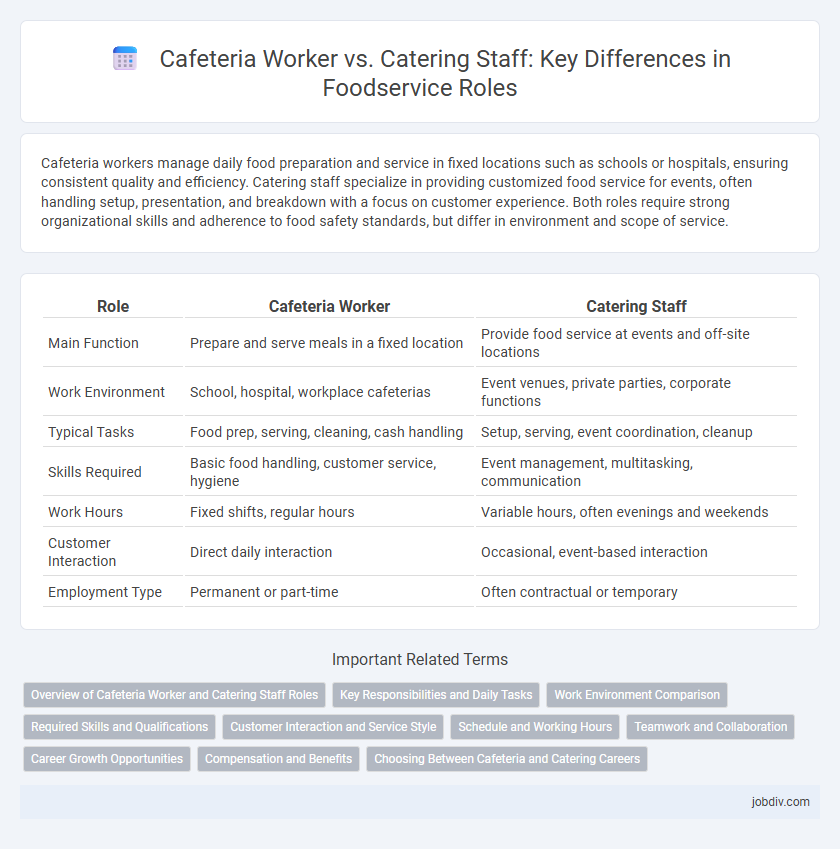Cafeteria workers manage daily food preparation and service in fixed locations such as schools or hospitals, ensuring consistent quality and efficiency. Catering staff specialize in providing customized food service for events, often handling setup, presentation, and breakdown with a focus on customer experience. Both roles require strong organizational skills and adherence to food safety standards, but differ in environment and scope of service.
Table of Comparison
| Role | Cafeteria Worker | Catering Staff |
|---|---|---|
| Main Function | Prepare and serve meals in a fixed location | Provide food service at events and off-site locations |
| Work Environment | School, hospital, workplace cafeterias | Event venues, private parties, corporate functions |
| Typical Tasks | Food prep, serving, cleaning, cash handling | Setup, serving, event coordination, cleanup |
| Skills Required | Basic food handling, customer service, hygiene | Event management, multitasking, communication |
| Work Hours | Fixed shifts, regular hours | Variable hours, often evenings and weekends |
| Customer Interaction | Direct daily interaction | Occasional, event-based interaction |
| Employment Type | Permanent or part-time | Often contractual or temporary |
Overview of Cafeteria Worker and Catering Staff Roles
Cafeteria workers typically prepare and serve food within fixed locations such as schools, hospitals, and corporate cafeterias, focusing on efficient meal distribution and maintaining food safety standards. Catering staff manage food service for events and off-site locations, emphasizing menu customization, presentation, and coordinated delivery. Both roles require strong customer service skills and adherence to health regulations but differ in work environment and scope of responsibilities.
Key Responsibilities and Daily Tasks
Cafeteria workers manage food preparation, serve meals directly to customers, and maintain cleanliness in high-traffic dining areas during fixed meal times. Catering staff plan and coordinate event-specific menus, set up serving stations, and provide personalized service to guest groups, often working flexible hours. Both roles require adherence to food safety standards but differ in environment and customer interaction intensity.
Work Environment Comparison
Cafeteria workers typically operate in high-traffic, institutional settings such as schools, hospitals, or corporate dining halls, where they handle repetitive food preparation and service tasks within fixed schedules. Catering staff work in diverse environments, including events, private parties, and corporate functions, requiring adaptability to different venues and client needs while managing variable shifts. The cafeteria setting offers a more structured routine, whereas catering demands flexibility and the ability to perform in dynamic, often fast-paced situations.
Required Skills and Qualifications
Cafeteria workers require skills in food preparation, customer service, and maintaining hygiene standards, often needing a high school diploma and basic food safety certification. Catering staff must demonstrate advanced culinary skills, event coordination, and strong communication abilities, typically holding certifications like ServSafe and experience in large-scale food service management. Both roles benefit from teamwork, time management, and adaptability, but catering staff often require higher expertise in menu planning and client interaction.
Customer Interaction and Service Style
Cafeteria workers engage in direct, routine customer interactions, serving food in a fast-paced, self-service environment that requires efficiency and consistency. Catering staff provide personalized, event-based service, focusing on tailored menus and attentive customer support, often including setup, presentation, and cleanup. The service style of cafeteria workers is standardized and quick, while catering staff prioritize customization and a high-touch experience to meet diverse client needs.
Schedule and Working Hours
Cafeteria workers typically operate on fixed shifts aligned with meal service times, often covering breakfast, lunch, and dinner hours in institutional settings like schools or hospitals. Catering staff usually work irregular hours, including evenings, weekends, and holidays, to accommodate event schedules and client demands. The flexibility required for catering roles contrasts with the more predictable, routine schedule of cafeteria workers.
Teamwork and Collaboration
Cafeteria workers and catering staff both rely heavily on teamwork and collaboration to ensure seamless foodservice operations, yet their environments demand different approaches. Cafeteria workers coordinate closely throughout the day to manage consistent meal preparation and service flow, emphasizing routine communication and quick problem-solving in a fast-paced setting. In contrast, catering staff collaborate intensively during event setup and execution, coordinating with clients and team members to customize menus and deliver flawless service tailored to specific occasions.
Career Growth Opportunities
Cafeteria workers often experience steady career growth through roles such as shift supervisors, kitchen managers, or food service coordinators within institutional settings like schools and hospitals. Catering staff have diverse advancement paths that include event management, sales coordination, and executive chef positions, driven by the dynamic nature of private event services. Both career tracks benefit from skill development in customer service, food safety, and operational logistics, but catering roles tend to offer higher earning potential and creative opportunities.
Compensation and Benefits
Cafeteria workers typically receive hourly wages ranging from $12 to $16, often accompanied by basic benefits such as meal discounts and limited health coverage. Catering staff salaries vary more widely, usually between $15 and $25 per hour, with some roles offering performance bonuses and flexible scheduling benefits tied to event-based work. Both positions may include access to employee discounts and occasional paid time off, but catering roles generally provide higher earning potential linked to tips and special event incentives.
Choosing Between Cafeteria and Catering Careers
Choosing between a cafeteria worker and catering staff career depends on work environment preferences and skill sets. Cafeteria workers often operate in fixed locations, focusing on consistent menu preparation and direct customer service within institutions like schools or hospitals. Catering staff require flexibility, managing event-based setups, personalized service, and logistics for diverse client needs, making adaptability and multitasking essential for success.
Cafeteria Worker vs Catering Staff Infographic

 jobdiv.com
jobdiv.com